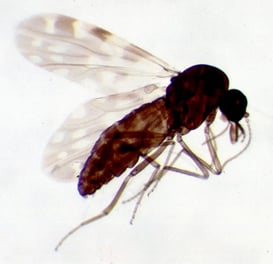
Bluetongue disease is transmitted by midges and affects ruminants like sheep and cattle. This page is your complete, end-to-end guide to the Bluetongue virus serotype 3 (BTV-3), covering its causes, clinical signs, serotypes, and control methods. It also serves as the central hub for all ongoing news, featuring a dedicated timeline of the latest outbreaks and updates across Europe.
Bluetongue is a viral vector borne disease that affects wild and domestic ruminants. Animals are infected by the bite of small midges known as culicoides (Figure 1)

Figure 1: Culicoides. Daktaridudu, 2016, CC BY-SA 4.0, via Wikimedia Commons
The virus responsible for the disease is the Bluetongue Virus (BTV), which comprises numerous serotypes (26 described to date), numbered 1 to 26. Unlike other viruses, antigenicity varies considerably from one serotype to another. There is therefore no cross-immunity, and vaccinating animals against one serotype does not protect against another.
In Europe some serotypes (1, 4, 16) have been present since the beginning of the 21st century and they are endemic in different parts, particularly the south and east of the continent. Through the use of vaccines those serotypes have been limited to these geographical areas, however, serotype 4 has spread northwards and an outbreak occurred in the French Alps near Lake Geneva in 2017.
New and large outbreaks occur when a new serotype arrives in a region previously free of that serotype. This happened in 2006 with the arrival of BTV serotype 8 in northern Europe. Firstly reported in The Netherlands, the virus spread to many other European countries causing significant losses to sheep and cattle producers. The development of an inactivated vaccine targeting the serotype 8 allowed to get the disease under control. The decrease of vaccination resulted in reemergence of the same serotype in central France in 2015. In 2023, BTV-8 has again been identified in France and it is being evaluated that we could be dealing with a new strain.
At the beginning of September 2023 a serotype endemic to South Africa1 but never before encountered in Europe was identified in The Netherlands. This new serotype is BTV-3.
Given the favourable climatic conditions for vector activity at this time of year (late summer and early autumn), the number of outbreaks increased rapidly and the disease spread to neighbouring countries. The first cases were confirmed in Belgium on September 29th and in Germany on October 10th. A first outbreak was even declared at the beginning of November, on the other side of the Channel, in the United Kingdom. However, the spread of the disease in this country has remained limited (3 outbreaks to date), probably due to weather conditions that are not very favourable to Culicoides activity at this time of year.
This timeline tracks the emergence and progression of the BTV-3 serotype in Europe, with links to our detailed coverage and analysis.
The clinical picture may vary depending on the serotype and the species infected. Among domestic species, cattle and goats are generally less severely affected than sheep, but this may vary according to serotype.
Whatever the serotype, the major clinical signs in sheep are as follows3 :
Serotype 3 appears to be particularly deadly. It has been estimated that this virus was responsible for the death of more than 51,000 sheep in the Netherlands in three months.
In cattle and goats, the signs are generally fewer, and mortality is less common. However, the currently emerging serotype 3 appears to be responsible for severe clinical signs in cattle too, although mortality remains lower than in sheep. In cows, udder lesions and reduced milk production have also been noted.
It is also important to note that abortions are not systematic and that a live, healthy calf or lamb may have been contaminated in utero if its mother was infected.
The spread of the disease is linked to the activity of the vector. Under European climatic conditions, culicoides are inactive during the winter period (between December and March-April). The number of new infections therefore falls during this period. However, since animals can be infected before birth, they represent a potential additional source of infection when the vector's activity resumes.
The best way to limit the health and economic impact of the disease would then be the use of a specific vaccine targeting the serotype 3 of the Bluetongue virus.
Animal movement restrictions introduced by the health authorities also help to reduce and slow the spread of the disease.
[1] Gray A. Bluetongue virus outbreak in northern Europe. Vet Rec. 2023 Oct 21;193(8):306. https://www.doi.org/10.1002/vetr.3571PMID: 37861165.
[2] Bulletins hebdomadaires de veille sanitaire internationale du 05/12/2023 (plateforme-esa.fr).

Philippe Gisbert started his career in 1994 as a Vet practitioner working with companion and farm animals for over 9 years. He then became Health Affairs Manager for Group Agena (artificial insemination company). In 2008 he joined Eurofins – Laboratoire Coeur de France as Animal Health Unit Manager where he worked for 7 years until he joined Ceva France as Technical Manager Ruminants (Infectiology, Vaccines and Diagnostic). Since 2020 he is Global Technical Manager for Biologicals, Udder Health and Antiinflammatories. He is a member of SIMV diagnostic and anti-infective technical groups and has integrated different working groups of ANSES and UNCEIA related to epidemiology, antibiotic resistance and reproduction in livestock.